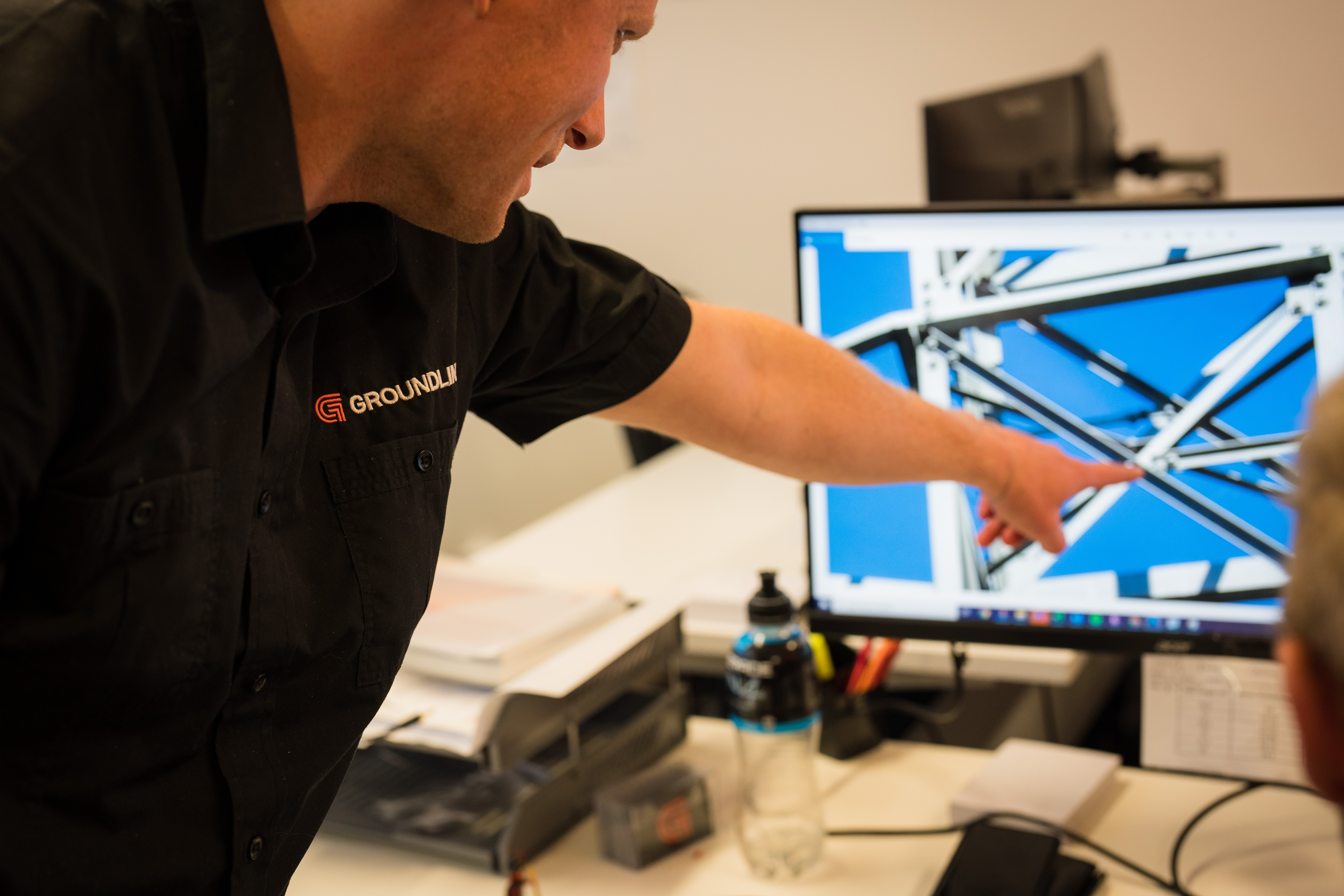Groundline at 20: Still challenging the status quo in electricity transmission

We can both clearly remember the reaction from our bosses and colleagues when we told them in late 2003 that we were quitting our jobs to go out on our own.
Richi Cleland and Ian Flatley reflect on 20years running Groundline Engineering.
“Why the hell would you want to do that?” was a common response. We were both in our early thirties, had young families and good jobs in large companies. We were on the upward track into management.
But neither of us was happy. The industry was dominated by old-school management thinking. Even worse was the prevailing view in the electricity transmission sector that distributed generation would do away with the need for maintaining a proper national grid.
It led to a strategy dubbed the “glide path”, which minimised spending on the grid, renewing lines, and, in extreme cases, selling off assets. We felt that was the wrong strategy, which turned out to be the case with the national grid, now more important than ever to meet our renewable energy future.
EARLY DAYS
Groundline initially started out providing non-destructive foundation testing services using a proprietary technology for which we had secured the Australasian rights. But we found civil contractors lost interest in foundations once the concrete had set. At the same time, the phone started ringing with enquiries from our network of power industry contacts looking for help with transmission lines, asset management and projects.
From a two-man operation in 2004 to the 70+-person organisation we are today, Groundline’s success has always been based on long-term relationships and a reputation for providing honest advice, innovative thinking, and high-quality service.
We’ve stuck to our knitting - providing overhead solutions and systems, and we’ve invested significantly in research and development to come up with novel conductors and innovative uses of GPS, cloud software, and seismic technologies.
ORGANIC GROWTH
It’s fair to say our growth to date has been “organic.” We definitely didn’t set out with a grand plan to have operations in Australia, the United Kingdom, and the United States. In each case, an opportunity presented itself to do some work offshore that led to us establishing a presence in each of those markets.
We learned early on that as businessmen and managers, we are chalk and cheese. Richi is the operations man, while Ian is the big picture thinker, constantly scanning for opportunities. It means that we complement each other.
In 2011, shortly after the Christchurch earthquake, we had a conversation over Richi’s kitchen table in which we both agreed we had to do things differently. We were no longer able to run things as the ‘Ian and Richi Show’, both of us with a hand in every part of the business, which was getting bigger and more complex.
The best thing we ever did was to team up with business consultant Clare Fountain, who helped us to map out our customer journey and systemise our processes. We only formally developed a business plan for Groundline around six years ago, which has built on that work, helping to scale up Groundline to the international business it is today.
GREAT PEOPLE
We continue to have a relatively flat structure at Groundline, but with a clear division of labour between the two of us as executive directors leading the business. We are not micro managers. We put a lot of effort into hiring great people and then trust them to do their work.
Ours is an industry where it's very difficult to secure skilled transmission line engineers, so we work very hard to retain the talent we have, and help our people develop their careers.
KEY MILESTONES
There have been some great milestones over the last 20 years.
Following the Royal Commission into the devastating 2009 Australian Black Friday bushfires, we won a grant from the Victorian government to develop new overhead conductors to reduce bushfire risk. We teamed up with Swedish company Amokabel to develop our Covered Conductor product and have enjoyed great success in Australia and attracted attention in other fire-prone markets.
Born out of Groundline, we created THOR Poletest to focus on helping customers manage their extensive utility timber pole assets; this business has enjoyed solid growth.
Our United Kingdom business started in 2015 with modest beginnings, but has grown significantly over the last decade, thanks in no small part to the guidance and commitment of Groundline’s United Kingdom General Manager and Director, Adam Yates.
That success gave us the confidence to start a beachhead in the US market, where Christian Nolden set up our office last year and serves as President of Groundline USA.
A major part of the journey has been both of us stepping away from hands-on operational delivery. We appointed Kyle James in 2019 to lead the NZ business; in 2020, this was extended to Australia.
Having confidence in our GMs has enabled the two of us to have greater focus on running the business and where we want to go next.
THE FUTURE
We never set out to run a multinational company, but we have been delivering services globally for many years now and see the next phase of Groundline’s growth being a truly global business.
When it comes to designing, deploying and maintaining transmission lines, we are still willing to challenge the status quo and to challenge the electricity industry to face up to the daunting infrastructure issues it faces – including ageing infrastructure, increased power demand and climate change.
An Economist cover story last year urged readers to “hug pylons, not trees”, pointing out the importance of electricity grids to the decarbonisation of the economy required to meet greenhouse gas emissions goals.
“Too little investment is taking place,” the Economist pointed out.
“Planning rules get in the way. And, in a deep and damaging irony, some of the biggest advocates of slowing climate change do not accept the logic that to do so requires building more.”
The Energy Transitions Commission estimates that 45% of the spending required to green the global economy will need to go into grid and storage capacity, a required collective spend of US$1.1 trillion a year between now and 2050. But worldwide current annual spending is estimated at only US$260 billion – a huge shortfall.
The green revolution will grind to a halt without the grid infrastructure needed to turn fossil fuel-burning industries electric and to flip the vehicle fleet from gas guzzlers to EVs.
At Groundline, we help our customers to think and act strategically to meet the demand for renewables.
It doesn’t always involve new infrastructure.
Our speciality is helping customers make the most of existing infrastructure. After all, it's far cheaper and less time-consuming to build on the pylons and poles you already have in place. The bottlenecks in investment have been particularly pointed out in the Australian market, where the impacts of climate change add further impetus to build a silent electricity grid.
We will continue to push for the long-term thinking and systems changes we believe are needed.
As we celebrate our 20th anniversary, we do so with a different lens on business and on life.
Personally, we are now in our fifties and more mature in thinking. We’ve learned many lessons the hard way, including the value of failing fast and, as the consultants put it, “shooting our puppies”.
We want to grow Groundline sustainably, forge partnerships with collaborators as we seek to grow existing markets and enter new ones, and take our expanding team along on the journey, with a keen eye on succession planning.
It’s been a hell of a ride, and we are forever thankful to every Groundline employee, past and present, for helping us get here.
Other News & Updates
Join us in welcoming Maia O’Reilly to the Groundline Team!
We’re thrilled to introduce Maia, a Graduate Engineer who is joining our New Zealand team.

Designing Electricity Infrastructure with the End in Mind: Why Asset Stewardship Must Begin at the Design Table
Sit in on any utility planning meeting and you’ll see the same challenge: project delivery dominates the agenda, while asset management fights for attention.

Reflections on the Global Energy Sector
As Groundline enters a new phase of growth and I find myself at the helm, I am in an interesting position where I am looking through two lenses. One on the ANZ market that I have operated in for 10+ years and the other on our global markets (UK, EU and USA).


Let’s Build Smarter, Safer, Stronger
Whether it’s a new project, technical support, or simply a conversation about possibilities — we’re here to help.












